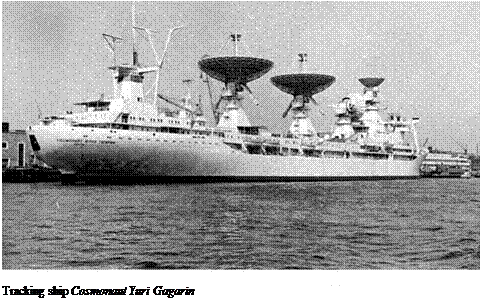TRACKING
To support the manned lunar effort, a fleet of maritime communication ships was constructed for the period when the manned lunar-bound or home-bound spacecraft would be out of direct line with the tracking stations in the Soviet Union. Initially, some merchant ships were converted to carry tracking equipment: the Ristna and Bezhitsa. Then some newly converted merchant ships were introduced: Kegostrov, Nevel, Morzhovets and Borovichi. Some small ground stations were set up in friendly states: in Chad, Cuba, Guinea, Mali and the United Arab Emirates.
 |
The big step forward was in May 1967, when a new class of large tracking ship was introduced, starting when the Vladimir Komarov was spotted making its way down the English Channel for its shake-down cruise. The Cosmonaut Vladimir Komarov displaced over 17,000 tonnes and had a crew of several hundred with large radar domes and antennae. Large though it was compared with its predecessors, it was small compared with the much larger tracking ships that followed: the Cosmonaut Yuri Gagarin (45,000 tonnes), which became the flagship and the Academician Sergei Korolev (21,250 tonnes). For Western observers, knowledge of the whereabouts of the tracking fleet was important in predicting Soviet lunar or manned missions. If the tracking ships were at sea, then missions could be expected (this became equally true of the Chinese manned space programme 30 years later).










